[ad_1]
You can take our freedom. But you can’t take our grainy old football videos. In this short series I will be exploring the contents of Fifa’s newly-released World Cup archive; re-visiting World Cup lore and World Cup truisms, and finding out if staring at them in peeled-eyeball detail from the confinement sofa really does reveal their deeper truths.
No1: USA ‘94 quarter-final, Dallas, 9 July 1994
It might seem odd in the current digital age, when everyone knows everything about everyone, but as recently as the mid-1990s European football could feel like another place entirely. There was still an otherness about those diffuse sporting cultures, something seen only in glimpses and at intervals.
The Dutch in particular were different. England had failed to make it out of the same group in qualifying for USA 94. There were elements of luck in the Netherland’s decisive victory in Rotterdam. But under Graham Taylor England had played a kind of extreme isolationist football, driven still by the island-nation game of the 1950s.
The Dutch didn’t just have better tactics or better players. There was something brittle and individualistic about their style, their way of carrying themselves. This was football of the left-bank, the unfiltered cigarette, the gap-year poncho. It might not have been enough to progress regularly through the late stages of knockout tournaments. It might have been expressed just as often in a Jan Wouters as a Dennis Bergkamp.
It helped that the Dutch had produced a tide of brilliant club footballers. The 1988 European champions showcased the star generation of Ruud Gullit and Marco van Basten. Six years on Van Basten was injured and Gullit had been dropped by Dick Advocaat just before the tournament. But the Dutch were if anything a deeper, stronger group now.
As ever there were stutters and false starts. Holland struggled through the group stage in America. Then they beat Ireland 2-0 in Orlando in the last-16. They came to Dallas to face Brazil with both teams in a position of strength. The winners of this quarter-final would face either Sweden or Romania in the semi, with the prospect of Spain, Bulgaria or a fretful-looking Italy in the final.
And so we cut to Fifa’s match-day film, as the teams walk out in lovely soft powder blue mid-afternoon light at the Cotton Bowl. This is an odd-looking sprawl of a stadium with huge square tiers rising up from the central stands, the whole thing crammed at kick off with basking orange and yellow.
Brazil come out holding hands in single file like a troupe of baby elephants heading off to the water hole, another indication of the strange combination of soppiness and ankle-hacking professionalism in those 1990s Brazil teams.

The Netherlands are in white shirts and orange shorts, a look that has something slightly pub change-strip about it, as though they’ve just turned their tops inside out. But the combination with Brazil’s royal blue is still dazzling, the staging, the colours, the light entirely of their own time and place.
The revved-up synth-pop USA 94 anthem dies away. Looking down the lines it is noticeable how clean-cut the Dutch seem. Ed de Goey is the only really grizzled face on show, but then the goalkeeper always looked as though he’d just come shambling on to the pitch from his Amsterdam bordello, cigarette in mouth, cat under one arm, dressing gown flapping.
The Dutch start quickly, weaving the ball through midfield, keeping possession. With three minutes gone Mazinho is fouled by Ronald Koeman. Branco shoots at goal from 40 yards (the Fifa commentator is amusingly unimpressed). Bergkamp is hacked down by Márcio Santos. And from there the tone is set for a tough, impossibly tight first half.
Brazil had dropped their captain and most creative midfielder Rai at the start of the tournament. By the time they got to Dallas Mario Zagallo had carved them into a brilliantly functional team, a group of mobile, tenacious footballers from mid-ranking club teams – Dunga is at Stuttgart, Mauro Silva is at Valencia – topped with the outright star wattage of Romário and the guile of Bebeto.
The Netherlands are much more fluent, keeping the ball easily in every part of the pitch, rotating positions in midfield, and moving with a kind of upright, easy arrogance. It is a familiar look. Of the 14 players Advocaat will use in these finals only De Goey and Stan Valckx are not products of the Ajax system. It felt at the time as though the Netherlands were on the right side of history with this.
The Ajax way had been aggressively revived in European club football, sped by the change in rules to make the game more technical and less physical; by the emergence of a generation of post-Rinus Michels coaches; and by relaxed European labour laws that allowed Dutch footballers to infiltrate elite clubs in every league. From 1992 to 1996 Ajax or the Ajax-influenced Barcelona reached the European Cup and Champions League final four times. USA 94 fell right in the middle.
In Dallas Aron Winter, Marc Overmars and Wim Jonk take turns in the playmaker role. Jan Wouters sits a little deeper, the same Wouters who broke Paul Gascoigne’s cheekbone at Wembley. And this Dutch team is notably physical, pressing together in small swarms, constantly seeking collisions.
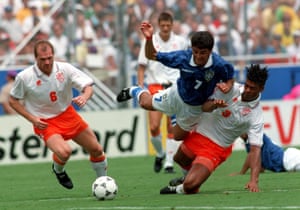
This is the most notable element of double-take looking back. Holland-Brazil 94 is a thrillingly tight, brutally disciplined version of football, a first half as aggressively compressed as the game can have ever been.
There is a tendency to imagine only progress in modern sport, to see superior athletes and data-driven tactical nous year on year. But these two teams can cover and track and press with startling efficiency. The modern game looks defensively slapdash, even a little carefree by comparison.
For a while the Netherlands switch possession from flank to flank, and it’s like watching a Pep Guardiola team, with Marc Overmars ducking inside, Peter van Vossen staying wide, and little overloads bubbling up. Brazil are unfazed. The blue shirts run and hustle like maniacs, filling every space and covering every run.
Van Vossen is punched and kicked to the ground by Aldair. Jorginho goes right through his ankles and you hear the scream. Wouters versus Dunga is like a middleweight title fight in central midfield. Romário gets his first little wriggle into space. Towards half-time Bergkamp takes a high ball on his big toe, sways inside Mazinho, a ghost suddenly, then shoots into the side netting. “It certainly hasn’t exploded into life yet,” the commentator says as the whistle blows for the break. No shit. But it is still gripping, tightly-knitted stuff.
The mistake the Dutch make is to let their levels drop just a little at the start of the second half, to wait to see where the game will go. Because suddenly things start to happen.
Bebeto is dropping deeper to turn with the ball, full-backs pushing on ahead of him. And Brazil’s aggression creates the space for the opening goal as the Netherlands look to break quickly behind them, but only give the ball straight to Marcio Santos. He hits an instant long diagonal pass out to Bebeto on the right and suddenly the white shirts have vacated the centre.
Bebeto runs on and and curls a low cross into the area. From there Romário’s finish is one-touch poetry. He hasn’t had a shot at goal at this stage. Another player might have snatched at it, or become tense. This is Romário though, who doesn’t really do tense.
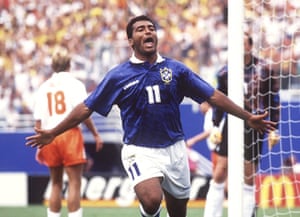
Instead he lets the ball run across him, then nudges it in a kind of pirouette-step off the outside of his foot and into the corner, producing in the middle of all this noise something startlingly inventive, an afterthought, a piece of fun, an improvised dance step.
At 1-0 down Holland send on Bryan Roy for Van Vossen. But they still look frantic. Frank Rijkaard takes a heavy touch, loses the ball and just sits down looking depressed. Someone has to lead here. A team response is required.
But it is all Brazil for a while. Bebeto hits the outside of the post. De Goey runs off his line to block with his chest from Romário. Brazil don’t look like a great team in these moments. But they look ruthless, razor-edged and totally clear in what they’re doing.
Finally something strange happens, although just as striking now is how utterly confusing it is for the Dutch defence. The ball is headed high over the half way line. Romário simply walks back under its arc from an offside position, as players do regularly now. At which point three Dutch players stop moving, baffled by this witchcraft.
Bebeto is away. One touch takes him around the keeper and two more put the ball in the empty net. The Brazil players go to the touchline and do the baby-rocking celebrations so many will later copy. The Fifa commentator muses ruefully on “the new offside rules… another sign of how little the players understand it”. He’s right. The Dutch, for all their modernity, were lost there.
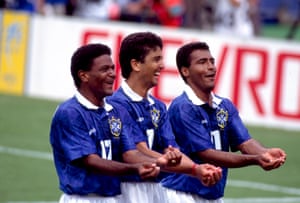
A minute later they’re back in it. Bergkamp strolls through on the left hand side of the area, all upright, easy elegance. He opens his hips a little and side-foots the ball across Cláudio Taffarel into the net.
Now the Dutch click, playing better than either team at any stage, playing champion football, finding their most regal pass and move rhythms. Ronald Koeman is bossing the game, stepping out and screaming at his teammates. Bergkamp drops deep, spinning in that easy way, a kind of two-footed ice-dance turn.
He sets up Winter for a shot, then hares off to the left and forces a corner. Overmars takes it. Winter runs across the six-yard box and heads the ball past Taffarel with thrilling power, the net billowing in cinematic fashion. It’s 2-2 from 2-0 down. The Netherlands are playing through a period of grace. We’ve got 14 minutes to go and this is surely heading only one way.
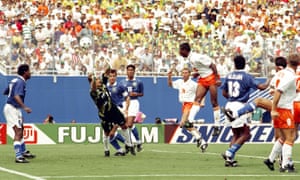
Except, once again, something else happens. Branco picks up the ball on the left, sees nothing ahead of him, hands off Overmars, and makes just enough ground before he’s tripped by Jonk and then kicked on the ground by Koeman.
“A questionable free-kick,” says the commentator but it’s exactly what Branco wanted. He steps back 15 paces, like a gymnast preparing to vault the horse, runs straight at the ball and punts it with the top of his foot, sending it veering and swerving and bouncing into the corner of De Goey’s net, the ball seized in that moment with a weird kind of voodoo.
Branco just keeps on running, pointing at someone on the Brazil bench. From a position of ascent the Dutch are losing again, and they just can’t gather themselves from here. All that craft, all that fine, imperious possession football – and they’ve never actually been in front in the game. It suddenly feels like the acme of the Netherlands in the 1990s, ultimate expression of a certain kind of high-end brittleness.
Branco is subbed off towards the end and actually goes around shaking hands with the opposition to waste more time. Holland look furious, but also lost. Five minutes of overtime don’t bring a single shot at goal. At the final whistle the blue-shirted bench is up leaping and dancing on the pitch, carrying out flags, the young Ronaldo there looking fresh and peppy and goofy.
Brazil were a little lucky to win at the Cotton Bowl. At the same time they carried a cutting edge that was just too much for the Netherlands. Perhaps the Dutch would also have gone on to win this World Cup from here. It was arguably their best chance.
The team of 1998 was even more talented, with Jaap Stam, Edgar Davids, Clarence Seedorf as well as Patrick Kluivert up front with Bergkamp. But the rest of the field was stronger by then too. Euro 1996 had taken a chunk out of Holland. Somehow those later teams lacked the meanness, the winning qualities of Rijkaard, Gullit and Koeman. The narrative arc seemed set, the notion of beautiful, brittle failure already written.
Brazil would go on to win two of the next three tournaments, and reach the final in between, vindication of their own golden crop. A more prosaic Netherlands team would reach the final 16 years later. Louis van Gaal, the dead hand of mid-90s Ajax-ism would take them to the semis 20 years on.
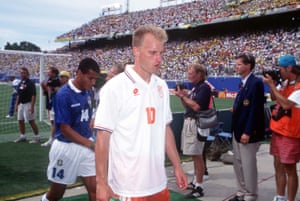
Was all this obvious in Dallas? Was it flagged in retrospect on Fifa’s archive film, a falling-short just waiting to be written? Was the Dutch project – fine technical football, strong characters, self-expression – hostage to its own flaws in an era of high-pressure collectivism?
Sport, as ever, turns on details. Versions of how we want to see it are picked out from a row of disconnected points. A move the other way, a free-kick not given, a save not made, and the conclusions would no doubt be different. All the Fifa archive really tells us is that those endlessly revolving variables fall a certain way and we find a story to fit. One thing is certain though. It is still a very good one.
[ad_2]
Source link